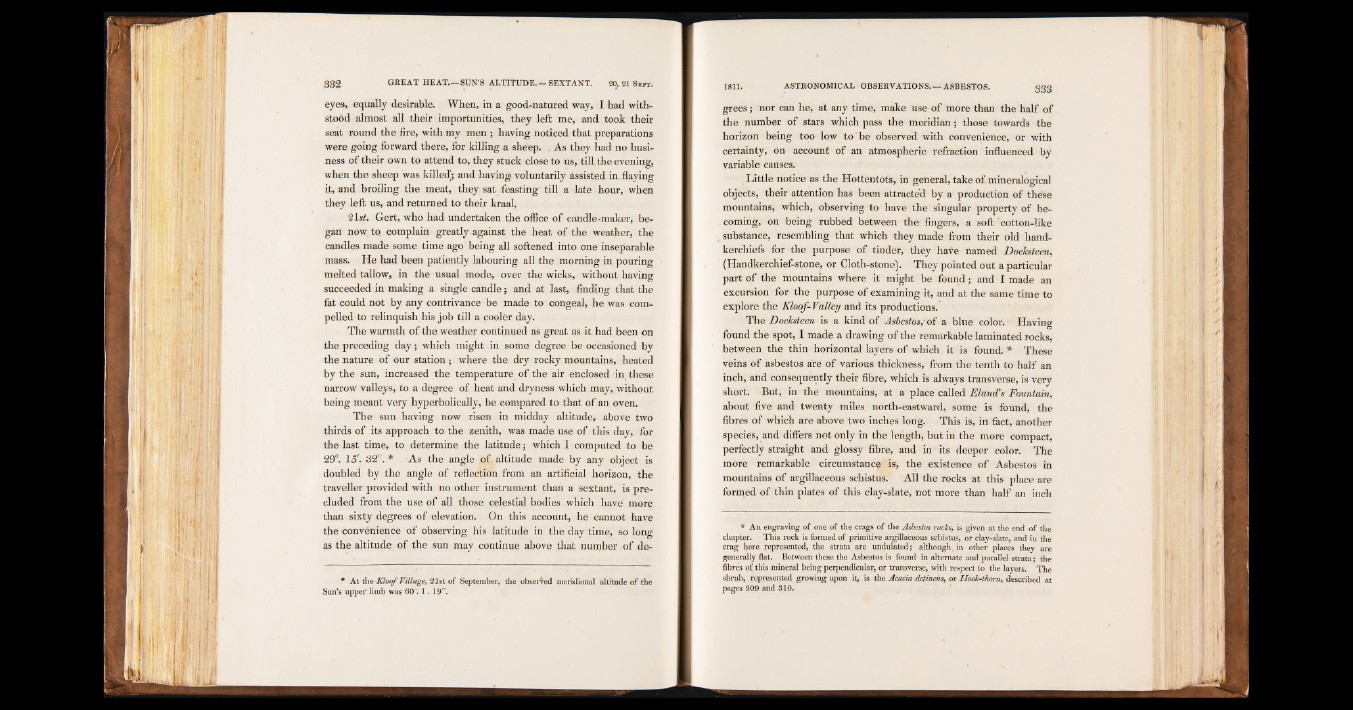
eyes, equally desirable. When, in a good-natured way, I had withstood
almost all their importunities, they left me, and took their
seat round the fire, with my men ; having noticed that preparations
were going forward there, for killing a sheep. . As they had no business
of their own to attend to, they stuck close to us, till the evening,
when the sheep was killed,'; and having voluntarily assisted in. flaying
it, and broiling the meat, they sat feasting'till a late hour, when
they left us, and returned to their kraal,
21 s t Gert, who had undertaken the office of candle-maker, began
now tq complain greatly against the heat of the weather, the
candles made some time ago being all softened into one inseparable
mass. He had been patiently labouring all the morning in pouring
melted tallow, in the usual mode, over the wicks, without having
succeeded in making a single candle; and at last, finding that the
fat could not by any contrivance be made to congeal, he was compelled
to relinquish his job till a coolfer day.
The warmth of the weather continued as great as it had been on
the preceding day; which might in some degree be occasioned by
the nature of our station ; where the dry rocky mountains, heated
by the sun, increased the temperature of the air enclosed in_ these
narrow valleys, to a degree of heat and dryness which may, without
being meant very hyperbolically, be compared to that of an oven.
The sun having now risen in midday altitude, above two
thirds of its approach to the zenith, was made use of this day, for
the last time, to determine the latitude j which I computed to be
29°. 15'. 32". * As the angle of altitude made by any object is
doubled by the angle of reflection from an artificial horizon, the
traveller provided with no other instrument than a sextant, is precluded
from the use of all those celestial bodies which have more
than sixty degrees of elevation. On this account, he cannot have
the convenience of observing his latitude in the day time, so long
as the altitude of the sun may continue above that number of de-
* At the K lo o f Village, 21st of September, the observed meridional altitude of the
Sun’s upper limb was 60’. 1'. 19".
grees; nor can he, at any time, make use of more than the half of
the number of stars which pass the meridian; those towards the
horizon being too low to'be observed with convenience, or with
certainty, on account of an atmospheric refraction influenced by
variable causes.
Little notice as the Hottentots, in general, take of mineralogical
objects, their attention has been attracted by a production of these
mountains, which, observing to have the singular property of becoming,
on being rubbed between the fingers, a soft cotton-like
substance, resembling that which they made from their old handkerchiefs
for the purpose of tinder, they have named Doeksteen,
(Handkerchief-stone, or Cloth-stone). They pointed out a particular
part of the mountains where it might be found; and I made an
excursion for the purpose of examining it, and at the same time to
explore the Kloof- Valley and its productions.
The Doeksteen is a kind of Asbestos,- of a blue color. Having
found the spot, I made a drawing of the remarkable laminated rocks,
between the thin horizontal layers of which it is found. * These
veins of asbestos áre of various thickness, from the tenth to half an
inch, and consequently their fibre, which is always transverse, is very
short. But, in the mountains, at a place called Eland's Fountain,
about five and twenty miles north-eastward, some is found, the
fibres of which are above two inches long. This is, in fact,, another
species, and differs not only in the length, but in the more compact,
perfectly straight and glossy fibre, and in its deeper color. The
more remarkable circumstance is, the existence of Asbestos in
mountains of argillaceous schistus. All the rocks at this place are
formed of thin plates of this clay-slate, not more than half an inch
* An engraving of one of the crags of the Asbestos rocks, is given at the end of the
chapter. This rock is formed of primitive argillaceous schistus, or clay-slate, and in the
crag here represented, the stratai are undulated; although, in other places they are
generally flat. Between these the Asbestos is found in alternate and parallel strata; the
fibres of this mineral being perpendicular, or transverse, with respect to the layers. The
shrub, represented growing upon it, is the Acacia detinens, or Hook-thom, described at
pages S09 and 310.